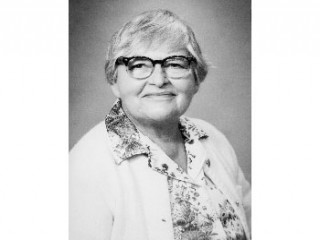
Dorothy Lewis Bernstein biography
Date of birth : 1914-04-11
Date of death : 1988-02-05
Birthplace : Chicago, Illinois, U.S.
Nationality : American
Category : Science and Technology
Last modified : 2011-02-25
Credited as : Mathematician, and educator, applied mathematics, statistics and computer programming
Dorothy Lewis Bernstein conducted research focused on the Laplace transform, a mathematical function used in the solution of partial differential equations that has been widely applied in the twentieth century in conjunction with operational calculus.
Dorothy Lewis Bernstein is a distinguished mathematician and educator in the fields of applied mathematics, statistics, and computer programming. Her research focused on the Laplace transform, a mathematical function named after the French mathematician Pierre-Simon Laplace. The Laplace transform is used in the solution of partial differential equations (equations that contain the partial derivatives of functions of two or more variables) and has been widely applied in the twentieth century in conjunction with operational calculus. Bernstein was a pioneer in incorporating applied mathematics and computer science into the undergraduate mathematics curriculum. In 1979, she became the first woman president of the Mathematical Association of America, a national association concerned with college mathematics.
Bernstein was born in Chicago on April 11, 1914, to Jacob and Tillie Bernstein, who were Russian immigrants. The family lived in Milwaukee during Bernstein's youth. In 1930, Bernstein began her studies at the University of Wisconsin at Madison. During her junior and senior years, she studied mathematics under an independent curriculum. In 1934, based on an oral examination and her thesis on the complex roots of polynomials (mathematical expressions containing certain algebraic terms), she received both a bachelor's (summa cum laude) and a master's degree in mathematics.
After another year at Madison as a teaching fellow, Bernstein received a scholarship to the doctoral program in mathematics at Brown University in Rhode Island. As Ann Moskol indicates in Women of Mathematics, Bernstein's experiences at Brown reflect various forms of discrimination. Bernstein's graduate teaching was restricted to only three female students. When she sought advice on finding a teaching position, the graduate school dean advised her not to apply in the South because she was Jewish or in the West because of her gender. Bernstein underwent an unusually arduous doctoral examination, which her advisor later acknowledged was due to her gender and to her midwestern university credentials.
Nonetheless, Bernstein independently secured a teaching position at Mount Holyoke College in Massachusetts. Bernstein taught at Mount Holyoke from 1937 to 1940, completing her doctorate from Brown in 1939 with a thesis related to the Laplace transform. In 1941, Bernstein returned to Madison as an instructor. In the summer of 1942, she was a research associate at the University of California at Berkeley under the Polish mathematician and statistician Jerzy Neyman. In 1943, Bernstein took an instructorship at the University of Rochester in New York, where she became an assistant professor in 1946.
At Rochester, Bernstein's research was directed toward exploiting the computational potential of digital computers (their ability to perform complex mathematical operations on large amounts of data at high speeds) in solving partial differential equations. This research, intended for military application and conducted in affiliation with the Office of Naval Research, led to the publication of Bernstein's Existence Theorems in Partial Differential Equations in 1950. In 1951, Bernstein was a member of the Institute for Advanced Study in Princeton, New Jersey. Bernstein became an associate professor at Rochester in 1951, and a full professor in 1957. From 1957 to 1958, she was a visiting professor at the University of California in Los Angeles.
In 1959, Bernstein assumed a professorship at Goucher College in Baltimore, Maryland, where she chaired the mathematics department from 1960 to 1970 and directed the computer center from 1961 to 1967. She served on the board of governors of the Mathematical Association of America, the professional association with which she was most closely involved, from 1965 to 1968. As a department administrator at Goucher, Bernstein brought applied mathematics and the emerging field of computer sciene into the undergraduate mathematics curriculum, and integrated computer programming into her own courses in statistics. Moskol notes that Bernstein "believed that applied mathematics not only made material more relevant to students, but it also motivated them to understand the axioms and theorems of pure mathematics, which could then be used in applied problems." Bernstein's practial vein was further indicated by the internship program she established for Goucher's math majors.
During her tenure at Goucher, Bernstein was also involved through the National Science Foundation in promoting computer programming instruction and the use of computers in advanced mathematics courses at area high schools. She helped establish the Maryland Association for Educational Use of Computers in 1972 and served on its governing board from 1972 to 1975. Bernstein was vice-president of the Mathematical Association of America from 1972 to 1974 and president from 1979 to 1981. She also served on the Joint Projects Committee and the Joint Committee on Women of the Mathematical Association of America, the American Mathematical Society, and the Society of Industrial and Applied Mathematics, and on the editorial board of the Two Year College Mathematics Journal. Bernstein retired from Goucher College in 1979.
















